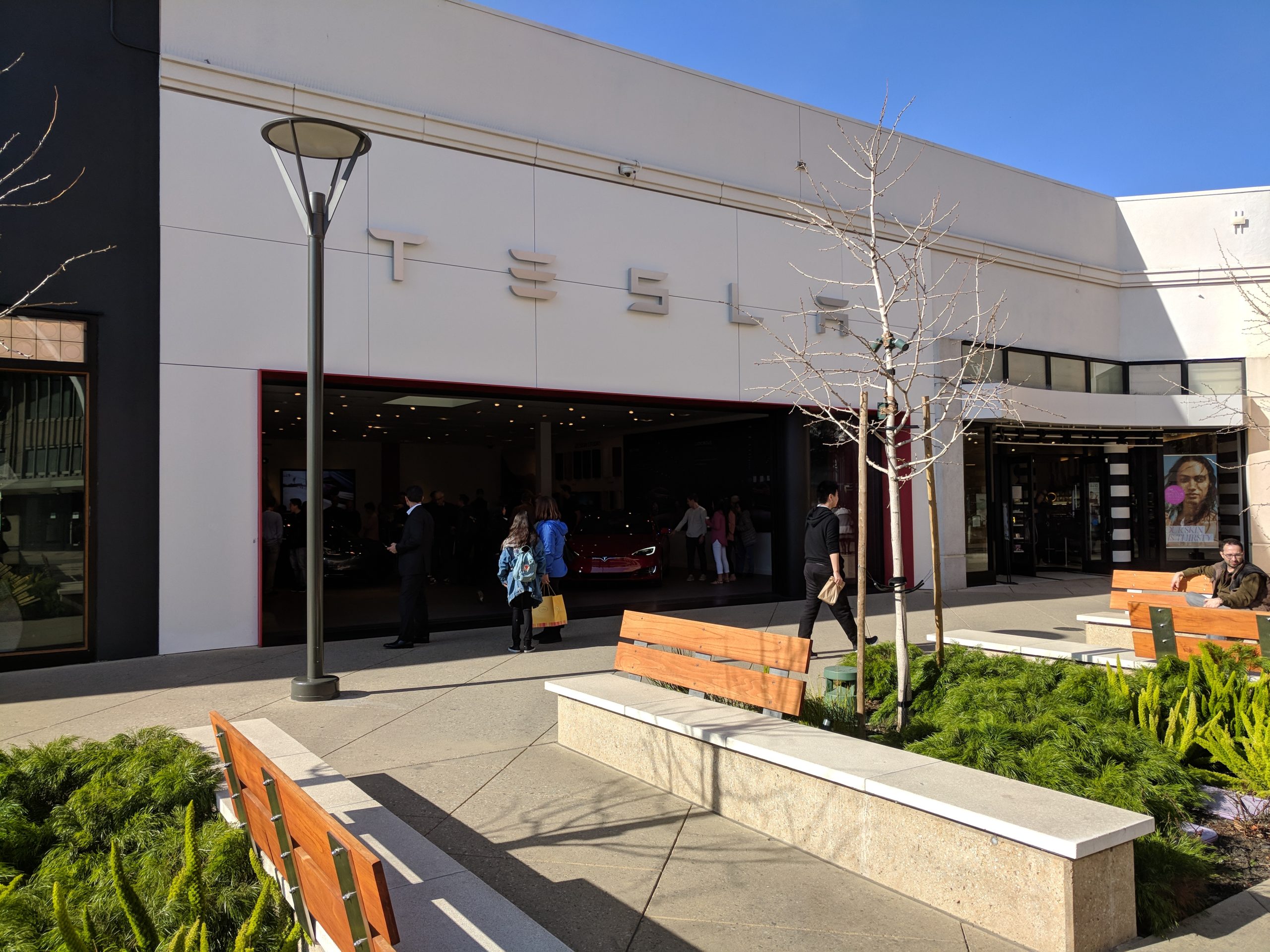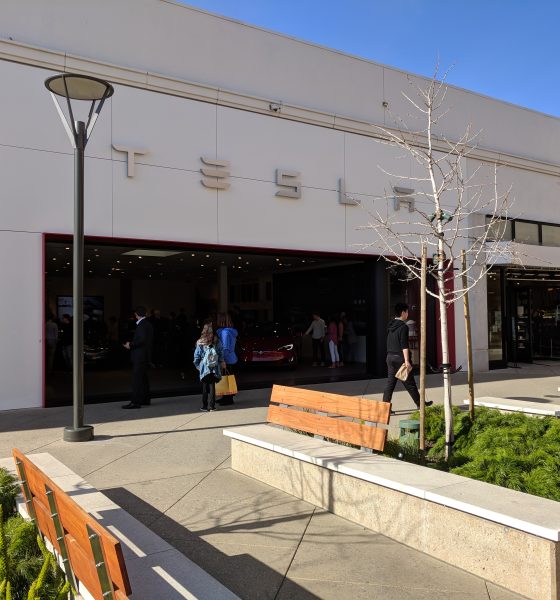

News
Tesla, Rivian still face complicated direct sales laws across U.S. states
Executives from both Tesla and Rivian have commented on the decades-long fight to overturn direct vehicle sales bans across many U.S. states, reigniting a long-held conversation in the electric vehicle (EV) community about dealership policy lobbying groups and online sales models.
Tesla has managed to side-step direct sales bans in many states through legal loopholes such as leasing-only models, processing purchases as out-of-state transactions, or simply opening stores in exempted tribal territories where the company’s stores will be exempt from dealership mandates. In other states, the company is still completely prohibited from selling vehicles, such as in Louisiana, where a U.S. appeals court just upheld Tesla’s right to sue the state over the direct-sales ban in August.
In Connecticut last July, Tesla managed to open a store on sovereign Mohegan tribal land, effectively side-stepping the U.S. state’s ability to prohibit direct sales. The Connecticut Automotive Retailers Association (CARA), a dealership lobbying group, immediately spoke out against the decision, though it gained support from Governor Ned Lamont.
Elsewhere, Tesla, Rivian, and many others sporting a direct sales model also face state store limits, and some executives have recently highlighted the decades-long fight to overturn these kinds of laws.
Other states have bans on service centers, storefronts, or both, while some only allow Tesla to sell vehicles online, though they must make deliveries through a service center. The latter includes Texas, where Tesla’s headquarters is located and where it operates a U.S. Gigafactory. As for Rivian, it faces a similar situation through its Seattle retail “Space,” since company representatives are prohibited from sharing specific details on prices or receiving orders.
As such, the state-to-state laws can be difficult for EV companies like Tesla and Rivian to wade through and operate under, so it shouldn’t come as much of a surprise when they point to dealership lobbying practices that keep them in place as being bad—or to their local teams who are working on overdrive.
Rivian CEO on state-to-state dealership laws
In a report published on Thursday, Rivian CEO RJ Scaringe said that dealership franchise laws were “as close as you can get to corruption,” as stated during a discussion with InsideEVs about whether Rivian’s recent Volkswagen partnership could let the startup work through VW dealerships. The report has reignited long-held discussions about states where Tesla, Rivian, and others aren’t allowed to operate—and seemingly due to powerful lobbying from dealership groups.
“Unfortunately, in the United States, it’s not an easy question,” Scaringe said as to the proposition of selling through VW’s dealers. “We have this horrific state-by-state level of rules that are as close as you can get to corruption.
“I think you essentially have, like, lots of dealers have paid for laws that make it really hard for us to interact directly with the consumer,” the Rivian CEO adds.
RELATED: Tesla granted license for direct vehicle sales in Kentucky
Tesla VP of Finance on state-to-state dealership laws
As a follow-up to the story, Tesla VP of Finance Sendil Palani shared his thoughts in a post on Saturday, praising the company’s local teams in states where direct sales are actively banned:
Tesla has been pursuing the direct-to-consumer model for two decades, and it has been an enormous challenge to pursue what we believe is the best model for customers.
I spent a portion of this past week visiting our Northeast region, and was reminded about how these laws are among our most prominent challenge for Sales and Delivery. Local teams make a heroic effort across the entire customer journey: from allowing customers to learn about our product at non-licensed locations while observing restrictions on sales activities, to managing a large flow of deliveries through a small number of licensed locations, to ensuring that we can properly perform vehicle registration paperwork for multiple states and customer circumstances at each licensed location.
Our customers have to make heroic efforts of their own, from traveling long distances to pick up their vehicle to patiently enduring any kinks in the process.
Sadly, this is common throughout much of the country, resulting in higher costs and a worse customer experience for the affected regions.
U.S. states with bans on direct sales models like at Tesla, Rivian
- Alabama (includes service centers)
- Arkansas
- Connecticut (leasing is allowed; tribal land loophole)
- Iowa
- Kansas (includes storefronts)
- Kentucky
- Louisiana (Tesla allowed through special license, “service center” model)
- Nebraska
- New Mexico (includes service centers; tribal land loophole)
- Oklahoma
- South Carolina (includes service centers)
- Texas (Tesla sells through online loophole, “service center” model)
- West Virginia (includes storefronts)
- Wisconsin
U.S. states with store limits on direct sales models like at Tesla, Rivian
- Illinois (limited to 13)
- Maryland (limited to 4)
- Mississippi (limited to 1)
- New Jersey (limited to 4)
- New York (limited to 5)
- North Carolina (limited to 6)
- Ohio (limited to 3)
- Pennsylvania (limited to 5)
- Virginia (limited to 5)
What are your thoughts? Did I miss anything, or do you have a story or opinion to share regarding direct auto sales? Let me know at zach@teslarati.com, find me on X at @zacharyvisconti, or send us tips at tips@teslarati.com.
DOJ echoes Tesla argument in Louisiana direct sales appeal

News
Elon Musk’s Grokipedia surges to 5.6M articles, almost 79% of English Wikipedia
The explosive growth marks a major milestone for the AI-powered online encyclopedia, which was launched by Elon Musk’s xAI just months ago.

Elon Musk’s Grokipedia has grown to an impressive 5,615,201 articles as of today, closing in on 79% of the English Wikipedia’s current total of 7,119,376 articles.
The explosive growth marks a major milestone for the AI-powered online encyclopedia, which was launched by Elon Musk’s xAI just months ago. Needless to say, it would only be a matter of time before Grokipedia exceeds English Wikipedia in sheer volume.
Grokipedia’s rapid growth
xAI’s vision for Grokipedia emphasizes neutrality, while Grok’s reasoning capabilities allow for fast drafting and fact-checking. When Elon Musk announced the initiative in late September 2025, he noted that Grokipedia would be an improvement to Wikipedia because it would be designed to avoid bias.
At the time, Musk noted that Grokipedia “is a necessary step towards the xAI goal of understanding the Universe.”
Grokipedia was launched in late October, and while xAI was careful to list it only as Version 0.1 at the time, the online encyclopedia immediately earned praise. Wikipedia co-founder Larry Sanger highlighted the project’s innovative approach, noting how it leverages AI to fill knowledge gaps and enable rapid updates. Netizens also observed how Grokipedia tends to present articles in a more objective manner compared to Wikipedia, which is edited by humans.
Elon Musk’s ambitious plans
With 5,615,201 total articles, Grokipedia has now grown to almost 79% of English Wikipedia’s article base. This is incredibly quick, though Grokipedia remains text-only for now. xAI, for its part, has now updated the online encyclopedia’s iteration to v0.2.
Elon Musk has shared bold ideas for Grokipedia, including sending a record of the entire knowledge base to space as part of xAI’s mission to preserve and expand human understanding. At some point, Musk stated that Grokipedia will be renamed to Encyclopedia Galactica, and it will be sent to the cosmos.
“When Grokipedia is good enough (long way to go), we will change the name to Encyclopedia Galactica. It will be an open source distillation of all knowledge, including audio, images and video. Join xAI to help build the sci-fi version of the Library of Alexandria!” Musk wrote, adding in a later post that “Copies will be etched in stone and sent to the Moon, Mars and beyond. This time, it will not be lost.”
News
Tesla Model 3 becomes Netherlands’ best-selling used EV in 2025
More than one in ten second-hand electric cars sold in the country last year was a Tesla Model 3.

The Tesla Model 3 became the most popular used electric car in the Netherlands in 2025, cementing its dominance well beyond the country’s new-car market.
After years at the top of Dutch EV sales charts, the Model 3 now leads the country’s second-hand EV market by a wide margin, as record used-car purchases pushed electric vehicles further into the mainstream.
Model 3 takes a commanding lead
The Netherlands recorded more than 2.1 million used car sales last year, the highest level on record. Of those, roughly 4.8%, or about 102,000 vehicles, were electric. Within that growing segment, the Tesla Model 3 stood far ahead of its competitors.
In 2025 alone, 11,338 used Model 3s changed hands, giving the car an 11.1% share of the country’s entire used EV market. That means more than one in ten second-hand electric cars sold in the country last year was a Tesla Model 3, Auto Week Netherlands reported. The scale of its lead is striking: the gap between the Model 3 and the second-place finisher, the Volkswagen ID3, is more than 6,700 vehicles.
Rivals trail as residual values shape rankings
The Volkswagen ID.3 ranked a distant second, with 4,595 used units sold and a 4.5% market share. Close behind was the Audi e-tron, which placed third with 4,236 registrations. As noted by Auto Week Netherlands, relatively low residual values likely boosted the e-tron’s appeal in the used market, despite its higher original price.
Other strong performers included the Kia Niro, the Tesla Model Y, and the Hyundai Kona, highlighting continued demand for compact and midsize electric vehicles with proven range and reliability. No other model, however, came close to matching the Model 3’s scale or market presence.
News
Tesla Model Y Standard Long Range RWD launches in Europe
The update was announced by Tesla Europe & Middle East in a post on its official social media account on X.

Tesla has expanded the Model Y lineup in Europe with the introduction of the Standard Long Range RWD variant, which offers an impressive 657 km of WLTP range.
The update was announced by Tesla Europe & Middle East in a post on its official social media account on X.
Model Y Standard Long Range RWD Details
Tesla Europe & Middle East highlighted some of the Model Y Standard Long Range RWD’s most notable specs, from its 657 km of WLTP range to its 2,118 liters of cargo volume. More importantly, Tesla also noted that the newly released variant only consumes 12.7 kWh per 100 km, making it the most efficient Model Y to date.
The Model Y Standard provides a lower entry point for consumers who wish to enter the Tesla ecosystem at the lowest possible price. While the Model 3 Standard is still more affordable, some consumers might prefer the Model Y Standard due to its larger size and crossover form factor. The fact that the Model Y Standard is equipped with Tesla’s AI4 computer also makes it ready for FSD’s eventual rollout to the region.
Top Gear’s Model Y Standard review
Top Gear‘s recent review of the Tesla Model Y Standard highlighted some of the vehicle’s most notable features, such as its impressive real-world range, stellar infotainment system, and spacious interior. As per the publication, the Model Y Standard still retains a lot of what makes Tesla’s vehicles well-rounded, even if it’s been equipped with a simplified interior.
Top Gear compared the Model Y Standard to its rivals in the same segment. “The introduction of the Standard trim brings the Model Y in line with the entry price of most of its closest competition. In fact, it’s actually cheaper than a Peugeot e-3008 and costs £5k less than an entry-level Audi Q4 e-tron. It also makes the Ford Mustang Mach-E look a little short with its higher entry price and worse range,” the publication wrote.








